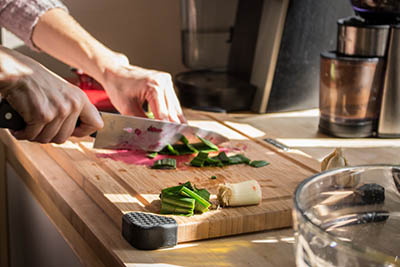
Detail of the “still life” fresco with pizza-like food item. Courtesy Archaeological Park of Pompeii.
While excavating a neighborhood in the ancient Roman city of Pompeii, which was destroyed in 79 CE by the eruption of nearby Mt. Vesuvius, a team led by archaeologists Alessandro Russo and Gennaro Iovino revealed a traditional-style home with a central atrium, kitchen shrine, oven, and beautiful frescoes. Most surprisingly, however, one of the frescoes includes a depiction that looks an awful lot like pizza, a cuisine that originated in Naples nearly 2,000 years later, in the 1800s.

A Well-Appointed Home
The area where the team is working was partially excavated in 1888 and 1891. Those efforts revealed the layout of the house’s central atrium and partially exposed the opening to an oven at one end, but did not penetrate into the surrounding structure. The new excavations have yielded a more complete picture of the home and its various rooms.

The ongoing excavation of the Pompeiian home, with the uncovered frescoes visible in the center of the photo. Courtesy Archaeological Park of Pompeii.
The atrium’s street entrance sits on its eastern side, while to the north are a laundry and a room with a burned bed that was destroyed in the eruption. At the west end of the atrium is a large oven, and in a nearby workroom the skeletons of three individuals were found. At the atrium’s southeast corner is a cluster of rooms that served as a kitchen area, extensively decorated with ornate frescoes of animals and geometric designs. According to the archaeologists, one of the rooms also functioned as a small shrine. “They would have made offerings here to their gods—foods like fish or fruits,” said Gabriel Zuchtriegel, director of the Pompeii archaeological park.
Epicurean Delights
The most impressive fresco, however, sits just outside and adjacent to the kitchen shrine. It depicts a variety of foods presented on a large silver tray, including a goblet of wine and various fruits and nuts. “I think about the contrast between a modest and simple meal that reminds us of a sphere that stands between the pastoral and the sacred on one side, and the luxury of the silver trays and the refinement of the artistic and literary representations on the opposite side,” said Zuchtriegel.
Of particular note is the fresco’s depiction of what looks like pizza, a cuisine invented in Naples in the late 1800s. Yet, notably absent here are staple pizza ingredients such as tomatoes and mozzarella cheese; instead, it appears to be a focaccia-like bread on which are placed various food items, possibly including a pomegranate and perhaps a date.
Nevertheless, the pizza association has struck a humorous chord even among the excavators. “I emailed a picture to my boss saying, ‘First the oven, now the pizza,’” said Iovino. The team anticipates that future visitors to Pompeii will undoubtedly demand to see the “ancestor to the pizza,” as it is now casually described.
Read more in Bible History Daily:
All-Access members, read more in the BAS Library:
The Destruction of Pompeii—God’s Revenge?
How to Find a Brothel in Pompeii
Not a BAS Library or All-Access Member yet? Join today.The post A Shrine, Frescoes, and…Pizza? appeared first on Biblical Archaeology Society.



0 Commentaires